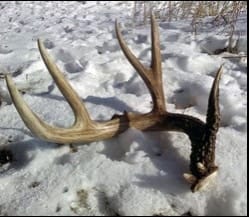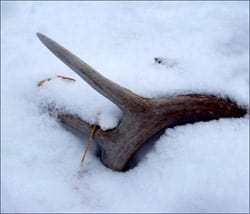“He’s still alive!” I thought as I reached down and picked up 71 inches of calcified happiness on my hunting land in central Minnesota. The shed antler I held belonged to a buck I saw once during the 2006 hunting season. He’s a symmetrical 5×5 with an inside spread of about 20 inches, putting him in the 160+ category.
Finding his left shed told me that this bruiser had made it through both the hunting season and winter unscathed. Given the mild winter we’ve had, I have no doubt he’s in good health as spring arrives.
I’ve since scoured the area looking for his other shed but haven’t found it yet. I’ll keep searching, in part because I desperately want his matched set and also because I love shed hunting. It’s a late winter/early spring ritual that offers excitement, exercise and also makes me intimately familiar with travel patterns of the deer I hunt.
 If you haven’t tried shed hunting yourself, I strongly encourage you to do so. There are few things more thrilling than wrapping your hand around a big antler-even if the antler isn’t attached to a deer you’ve harvested.
If you haven’t tried shed hunting yourself, I strongly encourage you to do so. There are few things more thrilling than wrapping your hand around a big antler-even if the antler isn’t attached to a deer you’ve harvested.
To help you get started, I’ve compiled a list of tips that might help as you go in search of that elusive whitetail headgear. And remember, if you find a big shed, it could be lying in the heart of that buck’s core area. I say “could” because a deer’s wintering grounds might be in a different location (based primarily on food sources) than where you’re likely to find the same animal during hunting season.
At any rate, you’ll know a particular buck is alive and will gain some insight on setting up a possible ambush point for him during the next season. Even if you don’t find any sheds—the trails, rub lines, scrapes, bedding areas and other things you’ll discover will make you a better hunter come fall.
Have They Dropped?
Whitetails can drop their antlers over a wide span of time. Here in the north (Minnesota), one buck might shed in December, while another male in the same area may not drop his antlers until March. Health, stress level and many unknowns can account for when a particular animal sheds. The best way I monitor when the deer in my area are shedding is to put my Cuddeback cameras out where most of my deer activity is taking place. By routinely checking your Cuddebacks in late winter/early spring, you can unequivocally discern when the “drop” is on.
Think Like a Deer and Find the Right Spots
Simple advice, but you won’t find a buck’s artifacts unless you’re crawling around where he lives. The savvy shed hunter is one who is prepared to put in some miles walking. An ATV can really help you cover more ground too. I’ll hop on my Honda and slowly drive my food plot edges first, keeping a watchful eye for antlers as I go.
Focus most of your efforts at or near food sources because that’s where most antlers will be found. During the winter, whitetails must feed heavily and conserve energy. So you’ll find that most deer will bed close to feeding areas. When you find these concentrated areas, there’s a good chance you’ll find antlers too.
When I cut well-used trails that connect main food sources to bedding areas, I go on foot and walk the trails. When on the trails, pay close attention to spots with thick overhanging cover that can snag a loose antler and knock it free. Also, fence lines, creeks and ravines that force deer to jump can also be falling-off points for treasured antlers.
 When you find the thickest, nastiest cover in a bedding area, get right into it. Having a bit of snow on the ground will help you locate actual beds in these areas and, sometimes, an antler or two will lie right there next to a big bed.
When you find the thickest, nastiest cover in a bedding area, get right into it. Having a bit of snow on the ground will help you locate actual beds in these areas and, sometimes, an antler or two will lie right there next to a big bed.
Also investigate the highest ground on the property you’re searching. Bucks like to bed on these vantage points to have a good, defensive viewing position. Plus, high spots and the south-facing slopes of these locations typically have less snow cover than low-lying areas. This means easier browsing opportunities for deer and an increased likelihood that a buck has dropped his antlers nearby.
When you find a nice shed, keep searching the area for the matched set. Often it will be within a couple hundred yards from the first one. When good tracking snow is still on the ground, back-tracking and forward-tracking the buck can lead you right to the match. From my experience, it seems like the bigger the rack, the more likely the antlers will be dropped in close proximity to one another. This could be because a big-racked buck doesn’t like the lopsided weight on one side of his head and intentionally shakes the other side free.
Tips for Spotting Antlers
First of all, try to look for “parts” of an antler vs. looking for the whole enchilada. Keep an eye out for the curve of a main beam, the tips of tines, etc. You can even train yourself to spot these telltale things by tossing an antler into tall grass, leaves and brush and then “hunting it up.”
When you take to the field, wear your polarized fishing glasses. They’ll cut down glare if there’s still snow on the ground and will also improve contrast for better spotting. And never go out shed hunting without a good pair of binocular. Binoculars are the key for surveying fields, hillsides and other open stretches. They can also save you a long walk for what you think is an antler off in the distance.
Man’s Best Friend
More and more shed hunters have put a dog’s keen nose to work finding sheds. In fact, many breeders/handlers now offer shed-hunting training right along with training for waterfowling, upland hunting and other canine tasks.
If you have a pup you’d like to train, it’s a pretty straightforward process and not too different than training a dog for blind retrieves on birds. A solid foundation of basic obedience skills is a must. From there, playing retrieval games with a shed antler sets the groundwork. Start by playing “fetch” in the yard where the dog can plainly see the antler. Remember to round off any sharp points from antlers to avoid injury to your dog. And it doesn’t hurt to reward him with little treats when he performs well. Reward training vs. forced training is definitely more beneficial when it comes to creating a good shed dog.
As you move into blind retrieves with your dog, this is where his skills will really develop. He’ll find the antlers with his nose and (if all goes well) will become obsessed with locating the scent of antlers, finding the source and delivering the prize to your hand.
I read a recent article by an outdoorsman who owns an accomplished shed-hunting dog. He reports that for every shed he finds himself, his dog finds 10. That’s a pretty good ratio (for the dog). Makes me think I should take my springer spaniel out and throw him a 5-point retrieving dummy.
Babe Winkelman is a nationally-known outdoorsman who has taught people to fish and hunt for more than 25 years.



